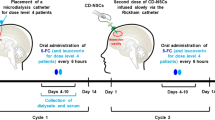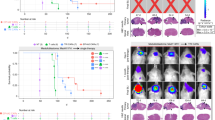Abstract
Medulloblastomas are highly malignant neuroectodermal cerebellar tumors of children. One of the reasons for the difficulty for the treatment of medulloblastomas is their inherent tendency to metastasize through the cerebrospinal fluid (CSF) pathway leading to leptomeningeal dissemination. Recently, genetically modified neural stem cells (NSCs) were shown to have the capability of selectively migrating into glioma mass and delivering therapeutic agents with significant therapeutic benefits. In the present study, we applied the NSC strategy to target medulloblastomas, particularly their leptomeningeal dissemination. We used NSCs that were retrovirally transduced with the cytosine deaminase gene (CD-NSCs). In vitro studies demonstrated that CD-NSCs had sufficient migratory activity toward medulloblastoma cells and exerted a remarkable bystander effect on these cells following the application of 5-fluorocytosine (5-FC). It is noteworthy that neutralization of the hepatocyte growth factor blocked their migration In animal studies using our leptomeningeal dissemination model, CD-NSCs implanted directly into CSF space were shown to distribute diffusely within the disseminated tumor cells and could provide remarkable antitumor effect after intraperitoneal administration of 5-FC. Furthermore, CD-NSC treatment followed by 5-FC administration prolonged survival periods significantly in experimental animals. Our data suggest that the CD-NSC strategy can also be applied to target leptomeningeal dissemination of medulloblastomas.
This is a preview of subscription content, access via your institution
Access options
Subscribe to this journal
Receive 12 print issues and online access
$259.00 per year
only $21.58 per issue
Buy this article
- Purchase on Springer Link
- Instant access to full article PDF
Prices may be subject to local taxes which are calculated during checkout






Similar content being viewed by others
References
Packer RJ . Brain tumors in children. Arch Neurol 1999; 56: 421–425.
David KM, Casey AT, Hayward RD, Harkness WF, Phipps K, Wade AM . Medulloblastoma: is the 5-year survival rate improving? A review of 80 cases from a single institution. J Neurosurg 1997; 86: 13–21.
Packer RJ, Sutton LN, Elterman R, Lange B, Goldwein J, Nicholson HS et al. Outcome for children with medulloblastoma treated with radiation and cisplatin, CCNU, and vincristine chemotherapy. J Neurosurg 1994; 81: 690–698.
Habrand JL, De Crevoisier R . Radiation therapy in the management of childhood brain tumors. Childs Nerv Syst 2001; 17: 121–133.
Inakoshi H, Kayamori R, Tsuchida E, Sakai K, Shibamoto Y, Wakushima H et al. Multivariate analysis of dissemination relapse of medulloblastoma and estimation of its time parameter for craniospinal irradiation. Radiat Med 2003; 21: 37–45.
Rutka JT, Hoffman HJ . Medulloblastoma: a historical perspective and overview. J Neurooncol 1996; 29: 1–7.
Packer RJ . Childhood medulloblastoma: progress and future challenges. Brain Dev 1999; 21: 75–81.
Mulhern RK, Kepner JL, Thomas PR, Armstrong FD, Friedman HS, Kun LE . Neuropsychologic functioning of survivors of childhood medulloblastoma randomized to receive conventional or reduced-dose craniospinal irradiation: a Pediatric Oncology Group study. J Clin Oncol 1998; 16: 1723–1728.
Gage FH . Mammalian neural stem cells. Science 2000; 287: 1433–1438.
McKay R . Stem cells in the central nervous system. Science 1997; 276: 66–71.
Yandava BD, Billinghurst LL, Snyder EY . ‘Global’ cell replacement is feasible via neural stem cell transplantation: evidence from the dysmyelinated shiverer mouse brain. Proc Natl Acad Sci USA 1999; 96: 7029–7034.
Park KI, Liu S, Flax JD, Nissim S, Stieg PE, Snyder EY . Transplantation of neural progenitor and stem cells: developmental insights may suggest new therapies for spinal cord and other CNS dysfunction. J Neurotrauma 1999; 16: 675–687.
Aboody KS, Brown A, Rainov NG, Bower KA, Liu S, Yang W et al. Neural stem cells display extensive tropism for pathology in adult brain: evidence from intracranial gliomas. Proc Natl Acad Sci USA 2000; 97: 12846–12851.
Ehtesham M, Kabos P, Kabosova A, Neuman T, Black KL, Yu JS . The use of interleukin 12-secreting neural stem cells for the treatment of intracranial glioma. Cancer Res 2002; 62: 5657–5663.
Ehtesham M, Kabos P, Gutierrez MA, Chung NH, Griffith TS, Black KL et al. Induction of glioblastoma apoptosis using neural stem cell-mediated delivery of tumor necrosis factor-related apoptosis-inducing ligand. Cancer Res 2002; 62: 7170–7174.
Barresi V, Belluardo N, Sipione S, Mudo G, Cattaneo E, Condorelli DF . Transplantation of prodrug-converting neural progenitor cells for brain tumor therapy. Cancer Gene Ther 2003; 10: 396–402.
Benedetti S, Pirola B, Pollo B, Magrassi L, Bruzzone MG, Rigamonti D et al. Gene therapy of experimental brain tumors using neural progenitor cells. Nat Med 2000; 6: 447–450.
Uhl M, Weiler M, Wick W, Jacobs AH, Weller M, Herrlinger U . Migratory neural stem cells for improved thymidine kinase-based gene therapy of malignant gliomas. Biochem Biophys Res Commun 2005; 328: 125–129.
Aghi M, Hochberg F, Breakefield XO . Prodrug activation enzymes in cancer gene therapy. J Gene Med 2000; 2: 148–164.
Freeman SM, Abboud CN, Whartenby KA, Packman CH, Koeplin DS, Moolten FL et al. The ‘bystander effect’: tumor regression when a fraction of the tumor mass is genetically modified. Cancer Res 1993; 53: 5274–5283.
Heese O, Disko A, Zirkel D, Westphal M, Lamszus K . Neural stem cell migration toward gliomas in vitro. Neuro oncol 2005; 7: 476–484.
Brown AB, Yang W, Schmidt NO, Carroll R, Leishear KK, Rainov NG et al. Intravascular delivery of neural stem cell lines to target intracranial and extracranial tumors of neural and non-neural origin. Hum Gene Ther 2003; 14: 1777–1785.
Li Y, Lal B, Kwon S, Fan X, Saldanha U, Reznik TE et al. The scatter factor/hepatocyte growth factor: c-met pathway in human embryonal central nervous system tumor malignancy. Cancer Res 2005; 65: 9355–9362.
Kleihues P, Ohgaki H . Primary and secondary glioblastomas: from concept to clinical diagnosis. Neuro oncol 1999; 1: 44–51.
Wechsler Reya R, Scott MP . The developmental biology of brain tumors. Annu Rev Neurosci 2001; 24: 385–428.
Pietsch T, Waha A, Koch A, Kraus J, Albrecht S, Tonn J et al. Medulloblastomas of the desmoplastic variant carry mutations of the human homologue of Drosophila patched. Cancer Res 1997; 57: 2085–2088.
Marino S, Vooijs M, van Der Gulden H, Jonkers J, Berns A . Induction of medulloblastomas in p53-null mutant mice by somatic inactivation of Rb in the external granular layer cells of the cerebellum. Genes Dev 2000; 14: 994–1004.
Badiali M, Pession A, Basso G, Andreini L, Rigobello L, Galassi E et al. N-myc and c-myc oncogenes amplification in medulloblastomas. Evidence of particularly aggressive behavior of a tumor with c-myc amplification. Tumori 1991; 77: 118–121.
Tomlinson FH, Jenkins RB, Scheithauer BW, Keelan PA, Ritland S, Parisi JE et al. Aggressive medulloblastoma with high-level N-myc amplification. Mayo Clin Proc 1994; 69: 359–365.
Cudkowicz M, De la Monte SM . Histogenesis and cell lineage analysis of medulloblastomas. J Neurol Sci 1989; 94: 221–229.
Schmidt NO, Przylecki W, Yang W, Ziu M, Teng Y, Kim SU et al. Brain tumor tropism of transplanted human neural stem cells is induced by vascular endothelial growth factor. Neoplasia 2005; 7: 623–629.
Ehtesham M, Yuan X, Kabos P, Chung NH, Liu G, Akasaki Y et al. Glioma tropic neural stem cells consist of astrocytic precursors and their migratory capacity is mediated by CXCR4. Neoplasia 2004; 6: 287–293.
Rosen EM, Lamszus K, Laterra J, Polverini PJ, Rubin JS, Goldberg ID . HGF/SF in angiogenesis. Ciba Found Symp 1997; 212: 215–226; discussion.
Bakshi A, Hunter C, Swanger S, Lepore A, Fischer I . Minimally invasive delivery of stem cells for spinal cord injury: advantages of the lumbar puncture technique. J Neurosurg Spine 2004; 1: 330–337.
Satake K, Lou J, Lenke LG . Migration of mesenchymal stem cells through cerebrospinal fluid into injured spinal cord tissue. Spine 2004; 29: 1971–1979.
Wu S, Suzuki Y, Kitada M, Kataoka K, Kitaura M, Chou H et al. New method for transplantation of neurosphere cells into injured spinal cord through cerebrospinal fluid in rat. Neurosci Lett 2002; 318: 81–84.
Pluchino S, Quattrini A, Brambilla E, Gritti A, Salani G, Dina G et al. Injection of adult neurospheres induces recovery in a chronic model of multiple sclerosis. Nature 2003; 422: 688–694.
Haberkorn U, Oberdorfer F, Gebert J, Morr I, Haack K, Weber K et al. Monitoring gene therapy with cytosine deaminase: in vitro studies using tritiated-5-fluorocytosine. J Nucl Med 1996; 37: 87–94.
Vermes A, Guchelaar HJ, Dankert J . Flucytosine: a review of its pharmacology, clinical indications, pharmacokinetics, toxicity and drug interactions. J Antimicrob Chemother 2000; 46: 171–179.
Huber BE, Austin EA, Richards CA, Davis ST, Good SS . Metabolism of 5-fluorocytosine to 5-fluorouracil in human colorectal tumor cells transduced with the cytosine deaminase gene: significant antitumor effects when only a small percentage of tumor cells express cytosine deaminase. Proc Natl Acad Sci USA 1994; 91: 8302–8306.
Corban Wilhelm H, Hull WE, Becker G, Bauder Wust U, Greulich D, Debus J . Cytosine deaminase and thymidine kinase gene therapy in a Dunning rat prostate tumour model: absence of bystander effects and characterisation of 5-fluorocytosine metabolism with 19F-NMR spectroscopy. Gene Therapy 2002; 9: 1564–1575.
Staflin K, Honeth G, Kalliomaki S, Kjellman C, Edvardsen K, Lindvall M . Neural progenitor cell lines inhibit rat tumor growth in vivo. Cancer Res 2004; 64: 5347–5354.
Suzuki T, Izumoto S, Wada K, Fujimoto Y, Maruno M, Yamasaki M et al. Inhibition of glioma cell proliferation by neural stem cell factor. J Neurooncol 2005; 74: 233–239.
Kim SU . Human neural stem cells genetically modified for brain repair in neurological disorders. Neuropathology 2004; 24: 159–171.
Hamada H, Kobune M, Nakamura K, Kawano Y, Kato K, Honmou O et al. Mesenchymal stem cells (MSC) as therapeutic cytoreagents for gene therapy. Cancer Sci 2005; 96: 149–156.
Acknowledgements
We thank Mr Mitsuo Kihira in the pathology laboratory at Kariya Toyota General Hospital (Kariya city, Aichi, Japan) for his great support with histological data in animal experiments.
Author information
Authors and Affiliations
Corresponding authors
Rights and permissions
About this article
Cite this article
Shimato, S., Natsume, A., Takeuchi, H. et al. Human neural stem cells target and deliver therapeutic gene to experimental leptomeningeal medulloblastoma. Gene Ther 14, 1132–1142 (2007). https://doi.org/10.1038/sj.gt.3302932
Received:
Accepted:
Published:
Issue Date:
DOI: https://doi.org/10.1038/sj.gt.3302932
Keywords
This article is cited by
-
Interferon-beta inhibits human glioma stem cell growth by modulating immune response and cell cycle related signaling pathways
Cell Regeneration (2022)
-
A facile and scalable in production non-viral gene engineered mesenchymal stem cells for effective suppression of temozolomide-resistant (TMZR) glioblastoma growth
Stem Cell Research & Therapy (2020)
-
In vivo bioluminescence imaging for leptomeningeal dissemination of medulloblastoma in mouse models
BMC Cancer (2016)
-
ID3 contributes to cerebrospinal fluid seeding and poor prognosis in medulloblastoma
BMC Cancer (2013)
-
Human neural stem cells expressing carboxyl esterase target and inhibit tumor growth of lung cancer brain metastases
Cancer Gene Therapy (2013)



